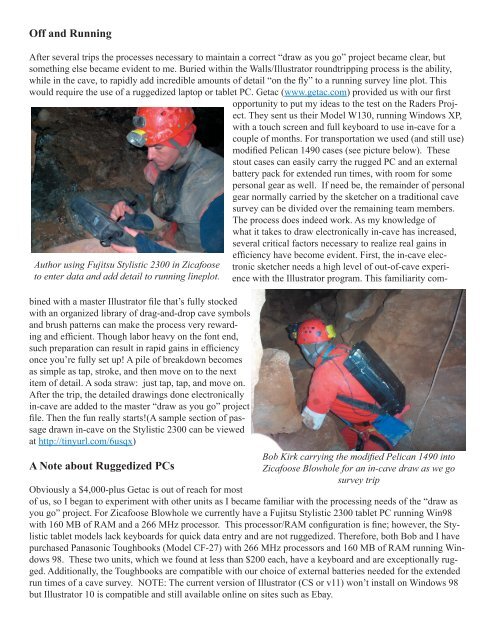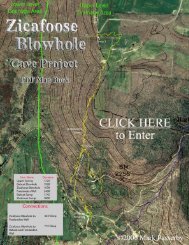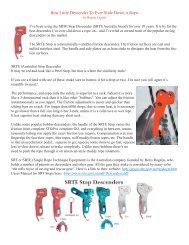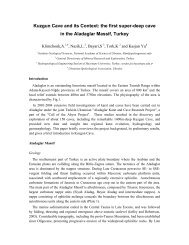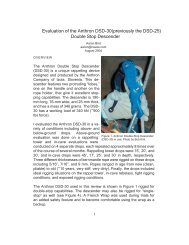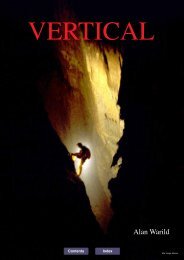Cavediggers.com Magazine Issue #9(PDF format)
Cavediggers.com Magazine Issue #9(PDF format)
Cavediggers.com Magazine Issue #9(PDF format)
Create successful ePaper yourself
Turn your PDF publications into a flip-book with our unique Google optimized e-Paper software.
Off and Running<br />
After several trips the processes necessary to maintain a correct “draw as you go” project became clear, but<br />
something else became evident to me. Buried within the Walls/Illustrator roundtripping process is the ability,<br />
while in the cave, to rapidly add incredible amounts of detail “on the fly” to a running survey line plot. This<br />
would require the use of a ruggedized laptop or tablet PC. Getac (www.getac.<strong>com</strong>) provided us with our first<br />
opportunity to put my ideas to the test on the Raders Project.<br />
They sent us their Model W130, running Windows XP,<br />
with a touch screen and full keyboard to use in-cave for a<br />
couple of months. For transportation we used (and still use)<br />
modified Pelican 1490 cases (see picture below). These<br />
stout cases can easily carry the rugged PC and an external<br />
battery pack for extended run times, with room for some<br />
personal gear as well. If need be, the remainder of personal<br />
gear normally carried by the sketcher on a traditional cave<br />
survey can be divided over the remaining team members.<br />
The process does indeed work. As my knowledge of<br />
what it takes to draw electronically in-cave has increased,<br />
several critical factors necessary to realize real gains in<br />
Author using Fujitsu Stylistic 2300 in Zicafoose<br />
to enter data and add detail to running lineplot.<br />
efficiency have be<strong>com</strong>e evident. First, the in-cave electronic<br />
sketcher needs a high level of out-of-cave experience<br />
with the Illustrator program. This familiarity <strong>com</strong>bined<br />
with a master Illustrator file that’s fully stocked<br />
with an organized library of drag-and-drop cave symbols<br />
and brush patterns can make the process very rewarding<br />
and efficient. Though labor heavy on the font end,<br />
such preparation can result in rapid gains in efficiency<br />
once you’re fully set up! A pile of breakdown be<strong>com</strong>es<br />
as simple as tap, stroke, and then move on to the next<br />
item of detail. A soda straw: just tap, tap, and move on.<br />
After the trip, the detailed drawings done electronically<br />
in-cave are added to the master “draw as you go” project<br />
file. Then the fun really starts!(A sample section of passage<br />
drawn in-cave on the Stylistic 2300 can be viewed<br />
at http://tinyurl.<strong>com</strong>/6usqx)<br />
Bob Kirk carrying the modifi ed Pelican 1490 into<br />
A Note about Ruggedized PCs<br />
Zicafoose Blowhole for an in-cave draw as we go<br />
survey trip<br />
Obviously a $4,000-plus Getac is out of reach for most<br />
of us, so I began to experiment with other units as I became familiar with the processing needs of the “draw as<br />
you go” project. For Zicafoose Blowhole we currently have a Fujitsu Stylistic 2300 tablet PC running Win98<br />
with 160 MB of RAM and a 266 MHz processor. This processor/RAM configuration is fine; however, the Stylistic<br />
tablet models lack keyboards for quick data entry and are not ruggedized. Therefore, both Bob and I have<br />
purchased Panasonic Toughbooks (Model CF-27) with 266 MHz processors and 160 MB of RAM running Windows<br />
98. These two units, which we found at less than $200 each, have a keyboard and are exceptionally rugged.<br />
Additionally, the Toughbooks are <strong>com</strong>patible with our choice of external batteries needed for the extended<br />
run times of a cave survey. NOTE: The current version of Illustrator (CS or v11) won’t install on Windows 98<br />
but Illustrator 10 is <strong>com</strong>patible and still available online on sites such as Ebay.


